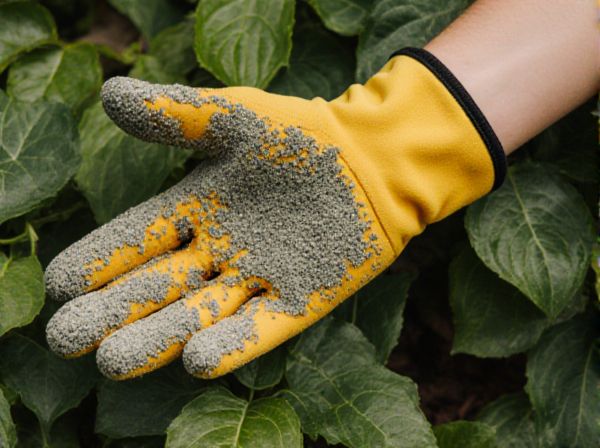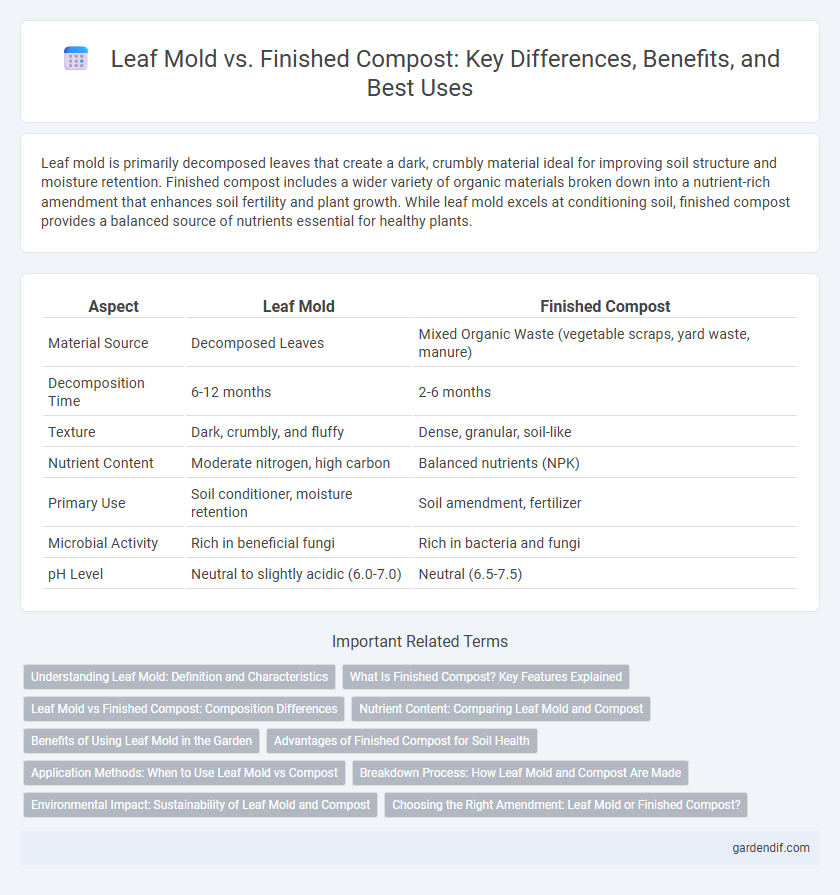
Leaf Mold vs Finished Compost Illustration
Leaf mold is primarily decomposed leaves that create a dark, crumbly material ideal for improving soil structure and moisture retention. Finished compost includes a wider variety of organic materials broken down into a nutrient-rich amendment that enhances soil fertility and plant growth. While leaf mold excels at conditioning soil, finished compost provides a balanced source of nutrients essential for healthy plants.
Table of Comparison
| Aspect | Leaf Mold | Finished Compost |
|---|---|---|
| Material Source | Decomposed Leaves | Mixed Organic Waste (vegetable scraps, yard waste, manure) |
| Decomposition Time | 6-12 months | 2-6 months |
| Texture | Dark, crumbly, and fluffy | Dense, granular, soil-like |
| Nutrient Content | Moderate nitrogen, high carbon | Balanced nutrients (NPK) |
| Primary Use | Soil conditioner, moisture retention | Soil amendment, fertilizer |
| Microbial Activity | Rich in beneficial fungi | Rich in bacteria and fungi |
| pH Level | Neutral to slightly acidic (6.0-7.0) | Neutral (6.5-7.5) |
Understanding Leaf Mold: Definition and Characteristics
Leaf mold is a type of organic matter created by the slow decomposition of fallen leaves, primarily composed of fungal activity rather than bacterial processes. It has a dark, crumbly texture and is rich in beneficial microbes that improve soil structure and moisture retention. Unlike finished compost, leaf mold lacks the diverse nutrient content but excels as a soil conditioner and mulching material.
What Is Finished Compost? Key Features Explained
Finished compost is a rich, dark, crumbly organic material resulting from the complete decomposition of organic matter, primarily kitchen scraps, garden waste, and other biodegradable materials. It is characterized by a balanced nutrient content, high microbial activity, and excellent moisture retention, making it an ideal soil amendment for improving soil structure and fertility. Unlike leaf mold, which is primarily composed of decomposed leaves and has a looser texture with lower nutrient levels, finished compost provides a more comprehensive array of nutrients essential for plant growth.
Leaf Mold vs Finished Compost: Composition Differences
Leaf mold primarily consists of decomposed leaves rich in carbon and fungal matter, creating a lightweight, moisture-retentive material ideal for soil conditioning. Finished compost contains a balanced mix of decomposed organic materials, including kitchen scraps, grass clippings, and leaves, offering diverse nutrients and microbial populations that enhance overall soil fertility. The key composition difference lies in leaf mold's focus on fungal dominance and carbon content, whereas finished compost provides a more nutrient-rich, microbially diverse amendment.
Nutrient Content: Comparing Leaf Mold and Compost
Leaf mold primarily consists of decomposed leaves rich in fungal biomass, offering high levels of cellulose and lignin but lower concentrations of readily available nutrients like nitrogen, phosphorus, and potassium compared to finished compost. Finished compost, derived from a diverse mix of organic materials including kitchen scraps, plant residues, and manure, provides a balanced nutrient profile with significantly higher levels of essential macronutrients critical for plant growth. This makes finished compost more effective as a soil amendment for immediate nutrient supplementation, while leaf mold excels in improving soil structure and moisture retention.
Benefits of Using Leaf Mold in the Garden
Leaf mold improves soil structure by increasing moisture retention and aeration, creating an ideal environment for root growth. It acts as a natural mulch, suppressing weeds and reducing the need for chemical fertilizers. The slow decomposition process results in a nutrient-rich, carbon-heavy amendment that enhances microbial activity and overall soil health.
Advantages of Finished Compost for Soil Health
Finished compost enhances soil health by supplying a rich source of nutrients, improving soil structure, and promoting beneficial microbial activity. It increases soil moisture retention and aeration, which supports root growth and nutrient uptake. Unlike leaf mold, finished compost provides a more balanced nutrient profile essential for plant development and disease resistance.
Application Methods: When to Use Leaf Mold vs Compost
Leaf mold excels in improving soil structure and moisture retention, making it ideal for mulching around trees, shrubs, and garden beds early in the growing season. Finished compost provides a nutrient-rich amendment perfect for enriching planting beds, vegetable gardens, and potted plants during soil preparation or transplanting. Applying leaf mold in spring enhances soil aeration, while finished compost supports active plant growth with essential nutrients throughout the growing cycle.
Breakdown Process: How Leaf Mold and Compost Are Made
Leaf mold forms through the slow decomposition of fallen leaves, primarily by fungal activity over one to two years, resulting in a dark, crumbly, and moisture-retentive material. Finished compost involves a faster breakdown process using a combination of microorganisms, bacteria, and fungi, which decompose kitchen scraps, yard waste, and other organic matter in a matter of months, producing nutrient-rich humus. Both processes enhance soil structure but differ in decomposition speed and microbial populations involved.
Environmental Impact: Sustainability of Leaf Mold and Compost
Leaf mold provides a sustainable way to recycle fallen leaves, enhancing soil structure while minimizing landfill waste and greenhouse gas emissions. Finished compost accelerates nutrient cycling by breaking down diverse organic materials, reducing the need for chemical fertilizers and promoting carbon sequestration. Both processes contribute significantly to soil health and environmental conservation, with leaf mold excelling in moisture retention and compost delivering a balanced nutrient profile.
Choosing the Right Amendment: Leaf Mold or Finished Compost?
Leaf mold, rich in decomposed leaves, excels at improving soil structure and moisture retention, making it ideal for enhancing garden beds and seed starting. Finished compost contains a balanced mix of decomposed organic matter, providing essential nutrients that boost soil fertility and support plant growth. Selecting between leaf mold and finished compost depends on whether soil aeration and water retention or nutrient enrichment is the primary amendment goal.
Leaf Mold vs Finished Compost Infographic

 gardendif.com
gardendif.com